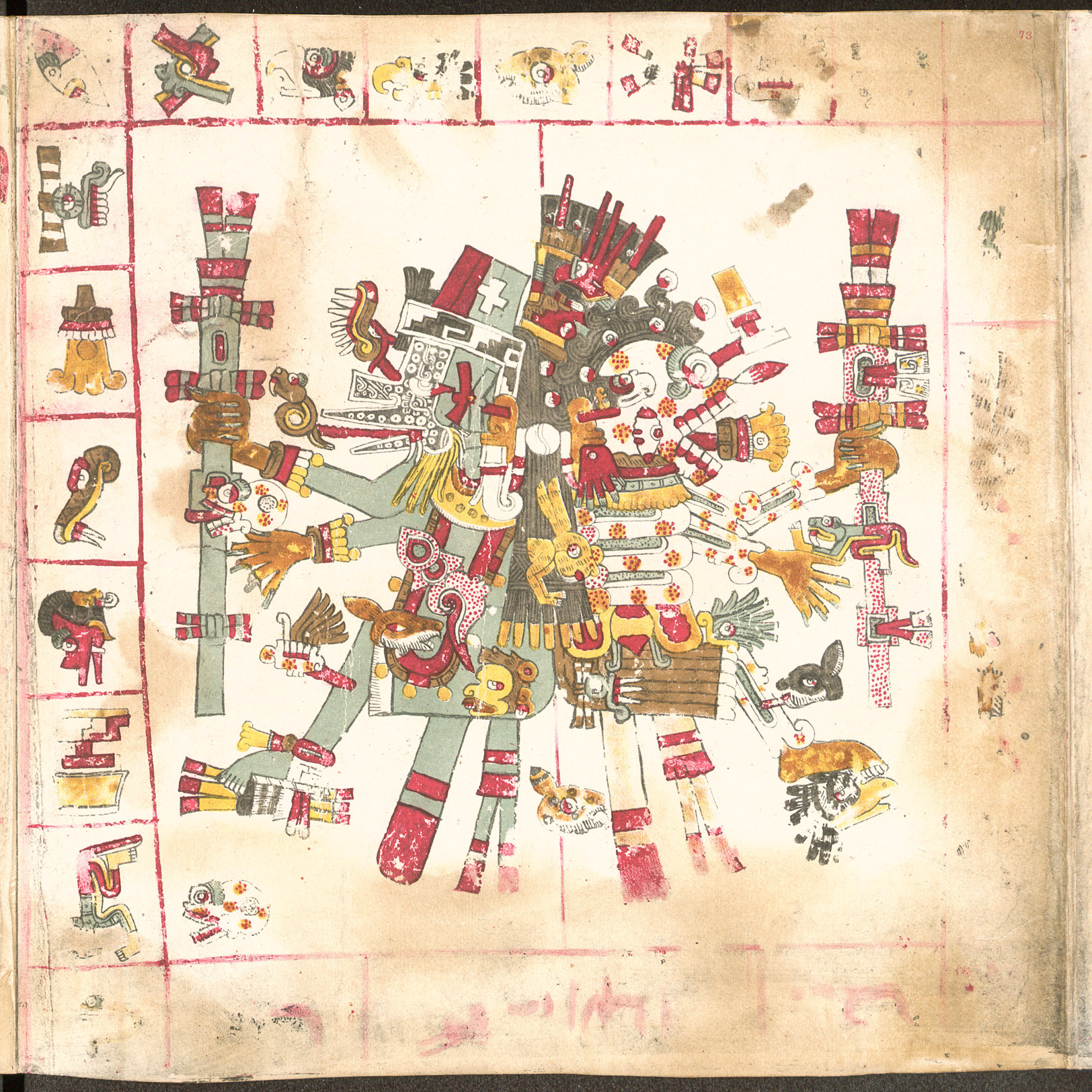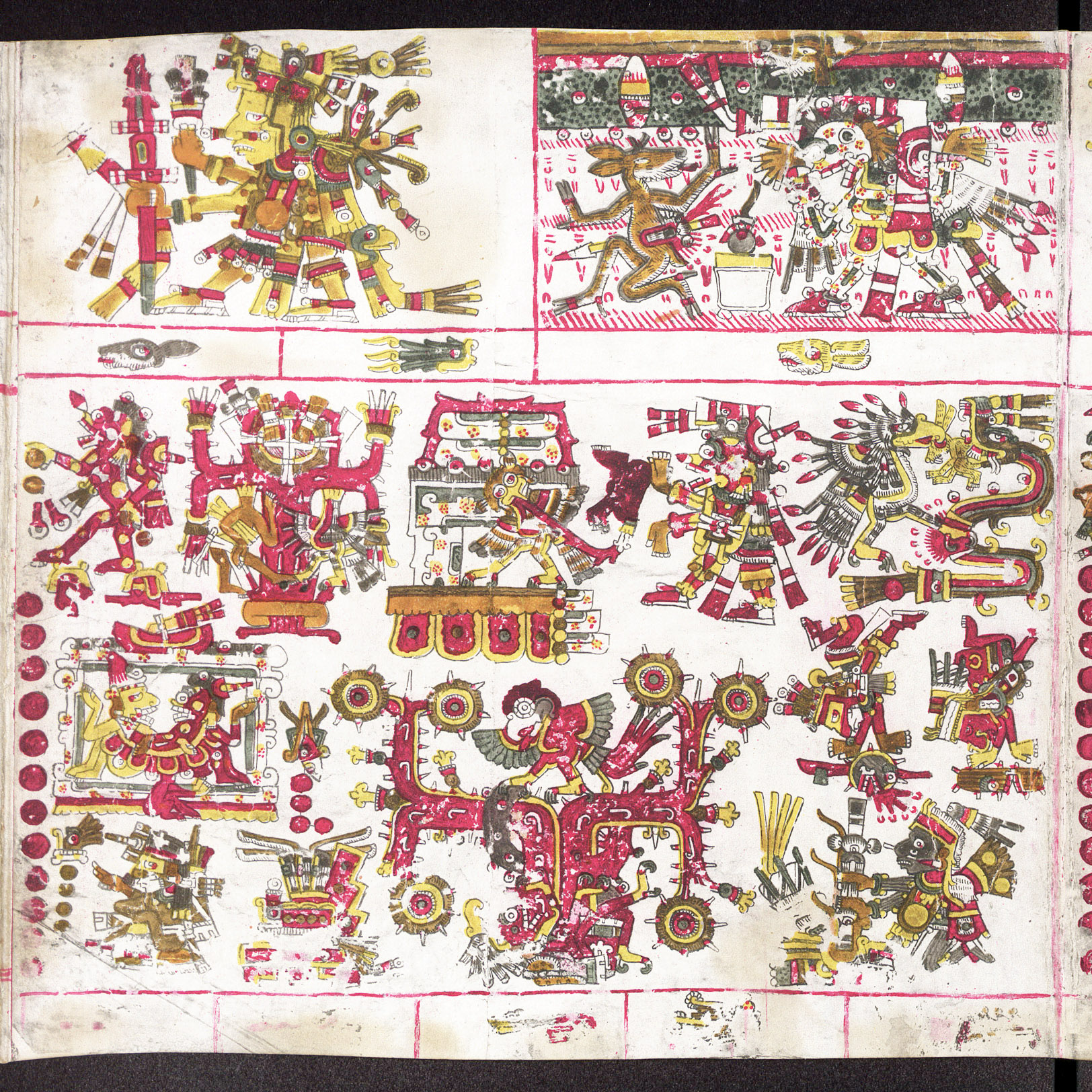|
Mictlāntēcutli
Mictlāntēcutli () or Mictlantecuhtli (, meaning "Lord of Mictlan"), in Aztec mythology, is a god of the dead and the king of Mictlan (Chicunauhmictlan), the lowest and northernmost section of the underworld. He is one of the principal gods of the Aztecs and is the most prominent of several gods and goddesses of death and the underworld. The worship of Mictlantecuhtli sometimes involved ritual cannibalism, with human flesh being consumed in and around the temple. Other names given to Mictlantecuhtli include Ixpuztec (“Broken Face”), Nextepehua (“Scatterer of Ashes”), and Tzontemoc (“He Who Lowers His Head”). Two life-size clay statues of Mictlantecuhtli were found marking the entrances to the House of Eagles to the north of the Great Temple of Tenochtitlan. Attributes Mictlantecuhtli was considered tall and was depicted as a blood-spattered skeleton or a person wearing a toothy skull.Miller & Taube 1993, 2003, p.113. Although his head was typically a skull, h ... [...More Info...] [...Related Items...] OR: [Wikipedia] [Google] [Baidu] |
Mictēcacihuātl
Mictēcacihuātl (, meaning "Lady of the Dead"), in Aztec mythology, is a death deity and consort of Mictlāntēcutli, god of the dead and ruler of Mictlān, the lowest level of the underworld. Her role is to watch over the bones of the dead and preside over the ancient festivals of the dead. These festivals evolved from Aztec traditions into the modern Day of the Dead after synthesis with Spanish traditions. She now presides over the contemporary festival as well. She is known as the "Lady of the Dead", since it is believed that she was born, then sacrificed as an infant. Mictēcacihuātl was represented with a flayed body and with jaw agape to swallow the stars during the day.Fernández 1992, 1996, p. 142. In popular culture *Mictēcacihuātl is a major character in ''Onyx Equinox''. *Under the name "Lady Micte", Mictēcacihuātl is a supporting character in ''Maya and the Three''. See also * Santa Muerte ''Nuestra Señora de la Santa Muerte'' (; Spanish for Our Lady of Holy ... [...More Info...] [...Related Items...] OR: [Wikipedia] [Google] [Baidu] |
Tezcatlipocas
In Aztec mythology, Creator-gods are the only four Tezcatlipocas, the children of the creator couple Ometecuhtli and Omecihuatl "Lord and Lady of Duality", "Lord and Lady of the Near and the Close", "Father and Mother of the Gods", "Father and Mother of us all", who received the gift of the ability to create other living beings without childbearing. They reside atop a mythical thirteenth heaven Ilhuicatl-Omeyocan "the place of duality". Each of the four sons takes a turn as Sun, these suns are the Five Suns, sun of earth, the Five Suns, sun of air, the Five Suns, sun of fire, the Five Suns, sun of water (Tlaloc, rain god replaces Xipe-Totec). Each world is destroyed. The present era, Five Suns, the Fifth Sun is ushered in when a lowly god, Nanahuatzin sacrifices himself in fire and becomes Tonatiuh, the Fifth Sun. In his new position of power he refuses to go into motion until the gods make sacrifice to him. In an elaborate ceremony, Quetzalcoatl cuts the hearts out of each of the ... [...More Info...] [...Related Items...] OR: [Wikipedia] [Google] [Baidu] |
Ah Puch
Cizin is a Mayan god of death and earthquakes. He is the most important Maya death god in the Mayan culture. Scholars call him God A. To the Yucatán Mayas he was Hun-Came and Vucub-Came. He also has similarities to Mictlāntēcutli. Name and etymology The God Cizin goes by several names like Kisen, Yom Cimil, Kisin, Ah Puch, Xibalba, Yum Cimil, Hunhau, Ah Puchah, Au Puch, Cum Hau, Eopuco, Hu Ahau, Tzontemoc, Ahpuch, and Ahal Puch. He was sometimes called Kimi. Mayans today call him ''Yum Cim'' or ''Yum Cimil''. The name Cizin probably means ''stench''. Cizin comes from the root "ciz" which means ''flatulence''. His name is said to mean Stinking One. Yum Cimil means ''lord of death'' while Hun Ahau means ''one ruler''. Ah Puch means to melt. Mythology He is considered the brother of Nohochacyum and Bacabs. According to Lacandon myth when a person dies Cizin burns the soul on his mouth and his anus. When the soul complains Cizin douses the soul in cold water, causing th ... [...More Info...] [...Related Items...] OR: [Wikipedia] [Google] [Baidu] |
Tenochtitlan
, ; es, Tenochtitlan also known as Mexico-Tenochtitlan, ; es, México-Tenochtitlan was a large Mexican in what is now the historic center of Mexico City. The exact date of the founding of the city is unclear. The date 13 March 1325 was chosen in 1925 to celebrate the 600th anniversary of the city. The city was built on an island in what was then Lake Texcoco in the Valley of Mexico. The city was the capital of the expanding Aztec Empire in the 15th century until it was captured by the Spanish in 1521. At its peak, it was the largest city in the pre-Columbian Americas. It subsequently became a '' cabecera'' of the Viceroyalty of New Spain. Today, the ruins of are in the historic center of the Mexican capital. The World Heritage Site of contains what remains of the geography (water, boats, floating gardens) of the Mexica capital. was one of two Mexica (city-states or polities) on the island, the other being . The city is located in modern-day Mexico City. Etymolo ... [...More Info...] [...Related Items...] OR: [Wikipedia] [Google] [Baidu] |
Earspool
A plug (sometimes earplug or earspool), in the context of body modification, is a short, cylindrical piece of jewelry commonly worn in larger-gauge body piercings. Modern western plugs are also called flesh tunnels. Because of their size—which is often substantially thicker than a standard metal earring—plugs can be made out of almost any material. Acrylic glass, metal, wood, bone, stone, horn, glass, silicone or porcelain are all potential plug materials. Plugs are commonly, and have historically, been worn in the ears. They can, however, be inserted into any piercing. In order for a plug to stay put within a piercing, the ends of its cylindrical shape are often flared out, or the plug is fastened in place by o-rings. Combinations of these two methods may also be used. * A double-flared (or saddle) plug, flares outward at both ends, and is thinner towards the middle. No o-rings are needed to keep the plug in the piercing, but the fistula needs to be wide enough to accomm ... [...More Info...] [...Related Items...] OR: [Wikipedia] [Google] [Baidu] |
Aztec Codices
Aztec codices ( nah, Mēxihcatl āmoxtli , sing. ''codex'') are Mesoamerican manuscripts made by the pre-Columbian Aztec, and their Nahuatl-speaking descendants during the colonial period in Mexico. History Before the start of the Spanish colonization of the Americas, the Mexica and their neighbors in and around the Valley of Mexico relied on painted books and records to document many aspects of their lives. Painted manuscripts contained information about their history, science, land tenure, tribute, and sacred rituals. According to the testimony of Bernal Díaz del Castillo, Moctezuma had a library full of such books, known as ''amatl'', or ''amoxtli,'' kept by a ''calpixqui'' or nobleman in his palace, some of them dealing with tribute. After the conquest of Tenochtitlan, indigenous nations continued to produce painted manuscripts, and the Spaniards came to accept and rely on them as valid and potentially important records. The native tradition of pictorial document ... [...More Info...] [...Related Items...] OR: [Wikipedia] [Google] [Baidu] |
Spider
Spiders ( order Araneae) are air-breathing arthropods that have eight legs, chelicerae with fangs generally able to inject venom, and spinnerets that extrude silk. They are the largest order of arachnids and rank seventh in total species diversity among all orders of organisms. Spiders are found worldwide on every continent except for Antarctica, and have become established in nearly every land habitat. , 50,356 spider species in 132 families have been recorded by taxonomists. However, there has been debate among scientists about how families should be classified, with over 20 different classifications proposed since 1900. Anatomically, spiders (as with all arachnids) differ from other arthropods in that the usual body segments are fused into two tagmata, the cephalothorax or prosoma, and the opisthosoma, or abdomen, and joined by a small, cylindrical pedicel, however, as there is currently neither paleontological nor embryological evidence that spiders ever had ... [...More Info...] [...Related Items...] OR: [Wikipedia] [Google] [Baidu] |
Mictlān
Mictlan () is the underworld of Aztec mythology. Most people who die would travel to Mictlan, although other possibilities exist. (see " Other destinations", below). Mictlan consists of nine distinct levels. The journey from the first level to the ninth is difficult and takes four years, but the dead are aided by the psychopomp, Xolotl. The dead must pass many challenges, such as crossing a mountain range where the mountains crash into each other, a field with wind that blows flesh-scraping knives, and a river of blood with fearsome jaguars. Mictlan also features in the Aztec creation myth. Mictlantecuhtli set a pit to trap Quetzalcoatl. When Quetzalcoatl entered Mictlan seeking bones with which to create humans, Mictlantecuhtli was waiting. He asked Quetzalcoatl to travel around Mictlan four times blowing a conch shell with no holes. Quetzalcoatl eventually put some bees in the conch shell to make sound. Fooled, Mictlantecuhtli showed Quetzalcoatl to the bones. But Quetzalcoa ... [...More Info...] [...Related Items...] OR: [Wikipedia] [Google] [Baidu] |
Templo Mayor
The (Spanish: Main Temple) was the main temple of the Mexica people in their capital city of Tenochtitlan, which is now Mexico City. Its architectural style belongs to the late Postclassic period of Mesoamerica. The temple was called ' in the Nahuatl language. It was dedicated simultaneously to Huitzilopochtli, god of war, and Tlaloc, god of rain and agriculture, each of which had a shrine at the top of the pyramid with separate staircases. The central spire was devoted to Quetzalcoatl in his form as the wind god, Ehecatl. The Great Temple devoted to Huitzilopochtli and Tlaloc, measuring approximately at its base, dominated the Sacred Precinct. Construction of the first temple began sometime after 1325, and it was rebuilt six times. The temple was destroyed by the Spanish in 1521, and the Mexico City cathedral was built in its place. The Zócalo, or main plaza of Mexico City today, was developed to the southwest of Templo Mayor, which is located in the block between Semi ... [...More Info...] [...Related Items...] OR: [Wikipedia] [Google] [Baidu] |



.jpg)


